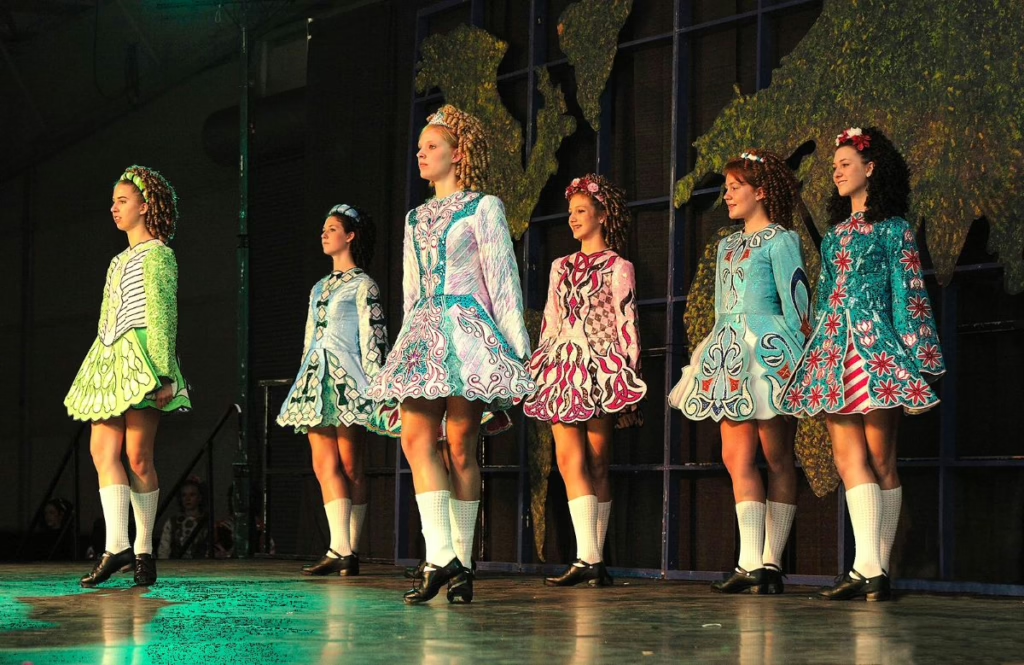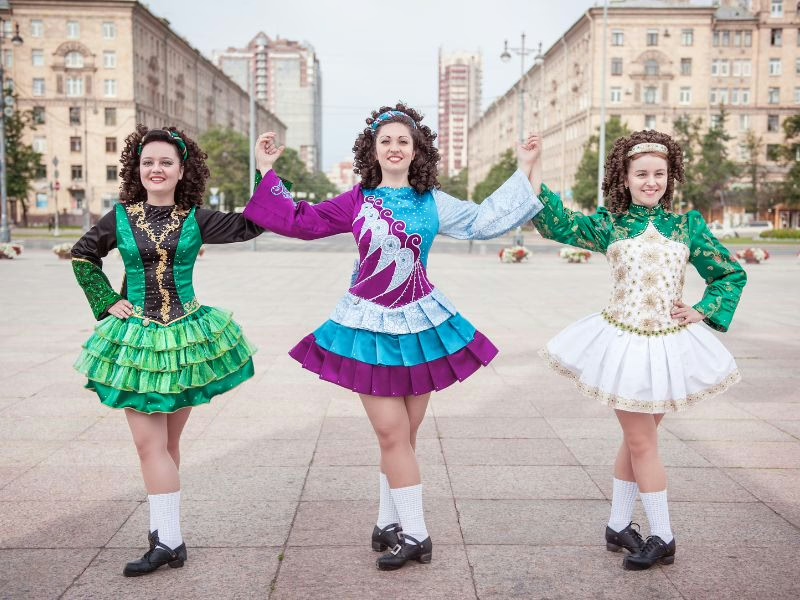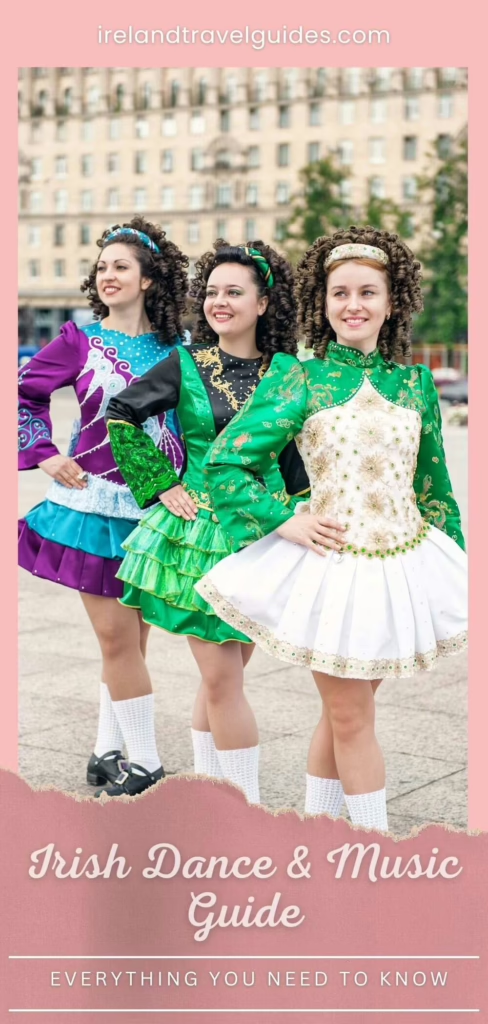Curious about Irish dance? This centuries-old tradition combines fast feet, expressive rhythms, and a cultural history that stretches from sacred rituals to sold-out Riverdance tours.
Whether you want to learn the basics, join a céilí, or just understand why everyone’s arms stay so stiff, Irish dance has a place for you.
Things you'll find in this article
- History of Irish Dance
- What is an Irish Dance Called
- What are the Characteristics of Irish Dance?
- What are the Styles & Types of Irish Dance
- What is the Traditional Dance of the Irish?
- What are the Traditional Irish Dance Costumes
- Modern Irish Dance Costumes
- Frequently Asked Questions about Irish Dance
- Final Thoughts
- Like it? Save it
History of Irish Dance

Like much of Irish culture, the dance tradition was first passed down by word of mouth (and by foot). Early Druids circled trees in ritual dances, and Celts gathered on the Hill of Tara for the “Aonach” festival with elaborate group performances.
By the 17th century, influences from English country dances and French quadrilles had shaped the steps. Irish dance has been evolving ever since, part ancient, part imported, and entirely Irish.
What is an Irish Dance Called
The term “Irish dance” covers a range of styles, though most people think of step dancing; the quick-footed, upright style that Riverdance catapulted onto the world stage.
But Irish dance isn’t just about stiff arms and lightning-speed feet. There are social dances, storytelling dances, and even pub-friendly freeform styles. Each one carries its own rhythm, story, and cultural weight.
If you’ve ever wanted to join in, céilí dancing is your best entry point: sociable, lively, and designed to make you forget you didn’t know the steps five minutes ago.
What are the Characteristics of Irish Dance?

You can spot Irish dance instantly. The upper body is poised and still, while the footwork does all the talking.
Soft shoes (ghillies) create graceful, flowing steps, while hard shoes add sharp, percussive rhythms that almost double as musical instruments. Dancers need stamina, agility, and nerves of steel, especially when performing in front of a crowd that knows every beat of the jig.
Whether solo or in groups, the precision and athleticism are unmistakable.
What are the Styles & Types of Irish Dance
Irish Céilí Dance
The social heart of Irish dance, céilí is about community as much as choreography. Danced in circles, lines, or squares – often at weddings or festivals – it welcomes all levels, sometimes with a caller guiding you through the steps.
Expect partner swaps, plenty of laughs, and a focus on connection over perfection.
Characteristics of Ceilí Dance
The Walls of Limerick
A longways dance where couples move forward, back, and turn together—simple, joyful, and a céilí staple.
The Siege of Ennis
Lively lines of dancers face off, creating a rhythm-driven mix of fun, friendship, and footwork.
Irish Sean-nós Dance
“Sean-nós,” pronounced shan-nohss, means “old style,” but the dance itself feels refreshingly free. Unlike step dancing, it’s relaxed, improvisational, and often performed in pubs to live music.
Characteristics of Sean-nós Dance
- Low Footwork: Movements stay close to the ground, creating subtle but intricate rhythms.
- Free Arm Movement: Arms move naturally, adding a conversational, storytelling feel.
- Informal Attire: No sequins required – jeans and enthusiasm are enough.
Irish Competition Dance
Competitions, or feiseanna, are held year-round, giving dancers the chance to perform solos or group routines under structured rules. For many, these contests are both sport and tradition, blending athleticism with cultural pride.
Irish Two-Hand Dance
A partner-based style that’s lighter and freer than set dancing. Couples move to jigs and hornpipes with spins, hops, and glides; accessible, lively, and a little less intimidating than group sets.
Irish Set Dance
Developed from 18th-century French quadrilles, set dancing is a social affair performed in groups of four couples. Each “set” has several short numbers danced to reels, polkas, or flings.
It’s intricate, communal, and nearly impossible not to smile while doing it.
What is the Traditional Dance of the Irish?

Traditional Irish dance falls into two broad categories: step dancing (including sean-nós) and social dances like céilí and set dancing.
Step dancing showcases rapid, complex footwork and controlled posture, while céilí and set dancing celebrate movement as a group activity. Both reflect the rhythm and spirit of Irish music.
What are the Traditional Irish Dance Costumes

The costumes are as iconic as the steps. Historically, women wore long skirts embroidered with Celtic designs, while men wore kilts or trousers with vests.
Modern competitive outfits have evolved into shorter, brightly decorated dresses for women (often with wigs and accessories) and sharp vests or jackets for men.
Traditional Irish Dance Costumes for Women
- Dresses/Blouses and Skirts
- Embroidery and Lace
- Capes and Brooches
Traditional Irish Dance Costumes for Men
- Shirts and Kilts
- Vests and Trousers
- Long Coats
Modern Irish Dance Costumes
Expect rhinestones, bold colors, and wigs for solo dancers. Beginners and group performers keep it practical with leotards, skirts, and trousers but always with the right shoes; ghillies for soft dances, hard shoes for that unmistakable percussive beat.
Frequently Asked Questions about Irish Dance
How to Irish dance?
Start small! Basic steps, simple rhythms, and a willingness to enjoy the music. Classes and workshops make it easy to join in.
Is Irish dance a sport?
Yes. It’s physically demanding, highly competitive, and requires endurance, agility, and skill.
What are the three main styles of Irish dancing?
- Set dancing
- Céilí routines
- Sean-nós
Final Thoughts
Irish dance isn’t just performance, it’s about participation. Whether you’re trying your first céilí, improvising sean-nós steps in a pub, or competing at a feis, it’s all about rhythm, connection, and tradition.
Slip on your dancing shoes (or at least tap along) and let the music guide you, because Irish dance isn’t just to be watched, it’s to be experienced.
Like it? Save it
